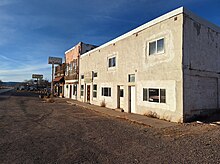| External image | |
|---|---|
The Lightning Field (1977) is a land art work in Catron County, New Mexico, by sculptor Walter De Maria. It consists of 400 stainless steel poles with solid, pointed tips, arranged in a rectangular 1 mile × 1 kilometre grid array. It is maintained by the Dia Art Foundation as one of 12 locations and sites they manage. While the work's title, form and best-known photographs may suggest the installation attracts lightning strikes, in fact these happen rarely.
History
The work was commissioned by Dia Art Foundation, which now maintains it. De Maria and his assistants Robert Fosdick and Helen Winkler traveled around California, Nevada, Utah, Arizona and Texas by truck for over five years before settling on this site for the large installation. It is 11.5 miles (18.5 km) east of the continental divide, at an elevation of 7,200 feet above sea level.
Set in the middle of an empty plateau about 40 miles from the nearest town, the work consists of 400 stainless steel poles arranged in the form of a grid. The grid measures 1 mile by 1 kilometer, and the poles are set 220 feet apart from one another. Accounting for natural ground-surface variance to create an isocephaly effect, the appearance of a level plane, the two-inch diameter poles were constructed to vary in height from 15 feet to 26 feet 9 inches. Each steel rod is set in its own concrete footing, three feet deep and one foot in diameter, buried one foot beneath the surface. They are designed to survive winds of up to 110 miles (180 km) an hour.
Support for maintaining and operating The Lightning Field is provided in part by an endowment established by Ray A. Graham III and Lannan Foundation, which awarded a challenge grant in 1996. Financial support for the permanent preservation of the undeveloped grasslands surrounding the installation has been provided by Dia's Board of Trustees, the State of New Mexico, De Maria's assistant Helen Winkler Fosdick, and Gucci.
By 2012, the structure as a whole needed reinforcement. To raise the estimated $400,000 needed to preserve Lightning Field, Larry Gagosian, whose gallery represents De Maria, and Miuccia Prada collaborated to lead the restoration effort. Work on the Lightning Field was to begin in early 2013, and the sculpture was to be reopened in June.
Representation in other media
A photograph of The Lightning Field was used as the cover image for Robert Hughes's 1997 book, American Visions: The Epic History of Art in America. The work featured prominently in the novel Blinded by the Light by Morgan Hunt. It may have influenced the imagery of author Cormac McCarthy's epilogue in his book Blood Meridian.
It is the subject of "Poles Apart" (2011), a New Yorker article by Geoff Dyer. David Ulin discusses the work as a narrative which "unfolds not as a fixed encounter but rather as something that gets inside us in a more sequential way." It inspired composer John Mackey's piece which he entitled "The Lightning Field".
Visiting

Open for six months of the year, the installation can be visited only by making advance reservations that include an overnight stay in the accommodations at the site. The site is a long drive from a scheduled meeting place in Quemado to a log cabin in the area.
The installation is intended to be viewed in isolation or with a very small group of people. A cabin on the site was restored to accommodate up to six people for this purpose. It has two bathrooms, a kitchen, and a common room. Camping at the site are not permitted.
See also
References
- ^ Gopnik, Blake (August 13, 2009). "Walter de Maria's 'Lightning Field' Encompasses a Vast New Mexican Vista". The Washington Post. Retrieved 12 June 2012.
- "Walter De Maria: Artist who forsook a career with The Velvet Underground to create electric, enigmatic installations". The Independent. London. August 15, 2013. Archived from the original on 2022-06-18. Retrieved November 27, 2020.
- Gibson, Todd (July 25, 2004). "A Pilgrimage to The Lightning Field". Retrieved 12 June 2012.
- ^ Dean, Cornelia (September 21, 2003). "Drawn to the Lightning". New York Times.
- Lam, Bourree (September 21, 2016). "Working With Lightning". The Atlantic. Retrieved November 27, 2020.
- "Walter de Maria, The Lightning Field - Funding". Dia Art Foundation. Archived from the original on June 21, 2012.
- "Gucci and Dia Art Foundation". Gucci. Archived from the original on August 18, 2012.
- Vogel, Carol (June 7, 2012). "Campaign Aims to Restore Weather-Abused 'Lightning Field'". New York Times.
- Campbell, Christopher D. (2002). "Walter De Maria's Lightning Field and McCarthy's Enigmatic Epilogue: 'Y que clase de lugar es este?'" (PDF). The Cormac McCarthy Journal. 2 (1). JSTOR 42909345. Archived from the original (PDF) on February 27, 2012. Retrieved July 12, 2023.
- Dyer, Geoff (April 18, 2011). "Poles Apart". The New Yorker. Retrieved 12 June 2012.
- Ulin, David L. (2010). The Lost Art of Reading: Why Books Matter in a Distracted Time. Seattle: Sasquatch Books. pp. 74–75. ISBN 9781570616709.
- "The Lightning Field".
External links
- Official website
- Photo gallery by Walter De Maria
- "Walter de Maria 'Lightning Field'". Accessible Art blog. 17 September 2010. Archived from the original on November 4, 2016. Retrieved July 31, 2017.
- The Lightning Field, article & photos at Atlas Obscura
34°31′0.14″N 108°6′20.95″W / 34.5167056°N 108.1058194°W / 34.5167056; -108.1058194
| Topics of Catron County, New Mexico | |
|---|---|
| Natural features | |
| Protected areas | |
| National Register of Historic Places listings |
|
| Historic people | |
| Historic places and events | |